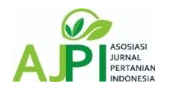Ammonia (Nh3) Excrete Production And Performance Of Broker Chickens With The Addition Of Turmeric Rhyme (Curcuma Longa) Flour To Drinking Water
DOI:
https://doi.org/10.58794/juragan.v2i1.636Keywords:
Ammonia, Broilers, Excreta, Turmeric, PerformanceAbstract
Ammonia is a gas resulting from the decomposition of protein residues in broiler chicken excreta. Turmeric (Curcuma longa) is a tropical plant that has antibacterial properties from the curcumin content and essential oils found in its rhizomes. The aim of this research was to determine the levels of ammonia excreta and the performance of broiler chickens by adding turmeric rhizome flour to their drinking water. There were 32 broiler chickens used. The feed used is starter and finisher phase feed. There were four treatments with four replications, namely treatment K0 (control), K1 (drinking water + 0.5 g/L amoxitin), K2 (drinking water + 16 g/L turmeric rhizome flour), K3 (drinking water + 20 g/L turmeric rhizome flour). The data obtained were analyzed for variance using a completely randomized design. Turmeric flour was given for three consecutive days before carrying out weekly performance measurements at the same time interval for four weeks. The parameters observed were performance (drinking water consumption, feed consumption, body weight gain, feed conversion, and final body weight), as well as ammonia production of broiler chickens. The results showed that giving turmeric rhizome flour had no significant effect of p>0.05 on the performance and ammonia production of broiler chickens with the best performance and lowest ammonia production in treatment K2 (drinking water + 16 g/L turmeric rhizome flour), namely drinking water consumption (197 .54±7.58 mL/e/d), feed consumption (83.57±5.14 g/e/d), feed conversion (1.65±0.14), body weight gain (51.08± 5.61 g/e/d), final body weight (1229.75±107.07 g/e) and ammonia production (33.20±7.54 mM). It can be concluded that the addition of 16 g/L turmeric rhizome flour (K2) to drinking water tends to produce better performance and less ammonia production
References
Akhavan, B. J., and P. Vijhani. 2019. Amoxicillin. In StatPearls [Internet]. StatPearls Publishing. https://www.ncbi.nlm.nih.gov/books/NBK482250/ ?report=classic. (Diakses 23 November 2019).
Badan Standarisasi Nasional. 2015. SNI 8173.3:2015. Pakan Ayam Ras Pedaging (Broiler) - Bagian 3: Masa Akhir (Finisher).
Dirjen Peternakan dan Kesehatan Hewan. 2018. Statistik Peternakan dan Kesehatan Hewan. Jakarta. Halaman 69-139.
Fadilah, R. 2005. Panduan Mengelola Peternakan Ayam Broiler Komersial (Edisi Revisi). Jakarta : Agromedia Pustaka. 60-61
Ferrier, D.R. 2014. Lippincott’s Illustrated Riviews Biokiamia Edisi ke-6, Jilid Dua. Tangerang Selatan : Binarupa Aksara Publisher. 9-10.
Ismarani. 2012. Potensi senyawa tannin dalam menunjang produksi ramah lingkungan. CEFARS: Jurnal Agribisnis dan Pengembangan Wilayah, 3(2) : 46-55.
Mahardhika, B. P., R. Mutia, and M. Ridla. 2019. Efforts to reduce ammonia gas in broiler chicken litter with the use of probiotics. IOP Conference Series: Earth and Environmental Science. 399 (1) : 1-6.
Natsir, M.H., E. Widodo, dan Muharlien. 2016. Penggunaan kombinasi tepung kunyit (Curcuma domestica) dan jahe (Zingiber officinale) bentuk enkapsulasi dan tanpa enkapsulasi terhadap karakteristik usus dan mikroflora usus ayam pedaging. Buletin Peternakan. 40 (1): 1-10.
Pratikno, H. 2010. Pengaruh ekstrak kunyit (Curcuma domestica Vahl) terhadap bobot badan ayam broiler (Gallus Sp). Buletin Anatomi dan Fisiologi. 18 (2) : 39-46
Pujianti, N.A., A. Jaelani, dan N. Widaningsih. 2013. Penambahan tepung kunyit (Curcuma domestica) dalam ransum terhadap daya cerna protein dan bahan kering pada ayam pedaging. Ziraa’ah. 36 (1) : 49-59
Purwanti, S., Zuprizal., T. Yuwanta., and Supadmo. 2014. Duodenum histomorphology and performance as influenced by dietary supplementation of turmeric (Curcuma longa), garlic (Allium sativum) and its combinationsas a feed additive in broilers. International Journal of Poultry Science. 13 (1) : 36-41.
Qurniawan, A., I. I. Arief, dan R. Afnan. 2017. Performans produksi ayam pedaging pada lingkungan pemeliharaan dengan ketinggian yang berbeda di sulawesi selatan. Jurnal Veteriner. 17 (4) : 622-633
Riza, H., W. Wizna, dan Y. Rizal. 2015. Peran probiotik dalam menurunkan amonia feses unggas. Jurnal Peternakan Indonesia. 17(1) : 19-26.
Rizal, Y. 2006. Ilmu Nutrisi Unggas. Padang: Andalas University Press. 5-6.
Rohaeni, E. S. 2005. Dampak pencemaran lingkungan dan upaya mengatasinya. Poultry Indonesia. 2005. 58-61.
Roni, N. G. K., E. Puspani, dan I. G. N. G. Bidura. 2015. Upaya menekan jumlah lemak tubuh dan gas amonia ekskreta itik melalui manajemen pakan probiotik. Majalah Ilmiah Peternakan. 18 (3) : 119-124.
Rosenthal, K.S., and M. J. Tan. 2011. Rapid Review Microbiology and Immunolog, Third Edition. Philadelphia (USA): Mosby Elsevier. 93
Said, A. 2007. Khasiat dan Manfaat Kunyit. Jakarta: Sinar Wadja Lestari. Halaman 11-13.
San C., dan Y. Iskandar. 2018. Studi kandungan dan aktivitas farmakologi tanaman kunyit (Curcuma longa L.). Farmaka. 16 (2) : 547-555.
Weaver W.D. 1991. The effect of different levels of relative humidity and air movement on litter conditions, ammonia levels, growth, and carcass quality for broiler chickens. Poultry Science. 70 : 746-755.
Widiawati, M. J., Muharlien, dan O. Sjofjan. 2018. Efek penggunaan probiotik dan tepung kunyit (Curcuma domestica val.) pada pakan terhadap performa broiler. Jurnal Ternak Tropika. 19 (2) : 105-110.
Winarto, W.P. 2003. Khasiat dan Manfaat Kunyit. Agromedia Pustaka, Jakarta. 2
Yasin, I. 2010. Pencernaan serat kasar pada ternak unggas. Jurnal Ilmiah Inkoma. 21 (3) : 125 - 135
Yusrini, H. 2002. Penangkapan dan pengukuran gas amonia pada kotoran ayam. Temu Teknis Fungsional Non Peneliti. Balai Penelitian Veteriner Bogor. 98-103.









